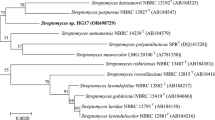Summary
The natural relationships among free-living and host-associated spirochetes were studied by investigating aspects of their morphology, physiology and DNA base composition. These studies indicated that the strictly and facultatively anaerobic, free-living spirochetes share characteristics which distinguish them from their host-associated counterparts and from the free-living leptospires.
It is suggested that the strictly and facultatively anaerobic, free-living spirochetes be grouped in the genus Spirochaeta and that this genus include the following four species: S. plicatilis (type species), S. stenostrepta, S. zwelzerae (Treponema zuelzerae), and S. aurantia. The characteristics of these species are described.
Similar content being viewed by others
References
Baseman, J. B., R. C. Henneberry, and C. D. Cox: Isolation and growth of Leptospira on artificial media. J. Bact. 91, 1374–1375 (1966).
Bessemans, A., and E. Van Thielen: Nouvelles données sur la pallidoïdose. Biométrie comparée du tréponème. C. R. Soc. biol. (Paris) 126, 261–264 (1937).
Bladen, H. A., and E. G. Hampp: Ultrastructure of Treponema microdentium and Borrelia vincentii. J. Bact. 87, 1180–1191 (1964).
Breed, R. S., E. G. D. Murray, and N. R. Smith: Bergey's manual of determinative bacteriology, 7th ed. Baltimore: Williams and Wilkins Co. 1957.
Breznak, J. A. and E. Canale-Parola: Characterization of a pigmented, facultatively anaerobic spirochete. Bact. Proc. 1968, 44.
Bruin, J. H. De: Serological relationship between Treponema zuelzerae and the Reiter strain of Treponema pallidum. Antonie v. Leeuwenhoek 27, 98–102 (1961).
Canale-Parola, E., S. C. Holt, and Zigrida Udris: Isolation of free-living, anaerobic spirochetes. Arch. Mikrobiol. 59, 41–48 (1967).
Cantacuzène, J.: Sur un spirochète thermophile des eaux de Dax. C. R. Soc. biol. (Paris) 68, 75–77 (1910).
Cohn, F.: Untersuchungen über Bakterien. Beitr. Biol. 1 (Heft 1), 180 (1872).
Cox, C. D.: Standardization and stabilization of an extract from Leptospira biflexa and its use in the hemolytic test for leptospirosis. J. infect. Dis. 101, 203–209 (1957).
— A. D. Alexander, and L. C. Murphy: Evaluation of the hemolytic test in the serodiagnosis of human leptospirosis. J. infect. Dis. 101, 210–218 (1957).
Dobell, C.: Researches on the spirochaets and related organisms. Arch. Protistenk. 26, 117–240 (1912).
Dujardin, F.: Histoire naturelle des zoophytes, p. 209. Paris 1841.
Dyar, M. T.: Isolation and cytological study of a free-living spirochete. J. Bact. 54, 483–493 (1947).
Ehrenberg, C. G.: Dritter Beitrag zur Erkenntnis großer Organisation in der Richtung des kleinsten Raumes. Abhandl. Berl. Akad. 313 (1833).
Ehrenberg, C. G.: Die Infusionsthierchen als volkommene Organismen, S. 83. Leipzig 1838.
Gardner, G.: Spirochaetes of the district of Montreal and the province of Quebec. Canad. J. Res. 7, 221–232 (1932).
Holt, S. C., and E. Canale-Parola: Fine structure of Spirochaeta stenostrepta, a free-living, anaerobic spirochete. J. Bact. 96, 822–835 (1968).
Lewin, R. A.: Saprospira grandis Gross; and suggestions for reclassifying helical, apochlorotic, gliding organisms. Canad. J. Microbiol. 8, 555–563 (1962).
Mandel, M.: Deoxyribonucleic acid base composition in the genus Pseudomonas. J. gen. Microbiol. 43, 273–292 (1966).
Manouélian, Y.: Étude morphologique du Spirochaeta pallida. Modes de division. Spirochétogène syphilitique. Ann. Inst. Pasteur 64, 439–455 (1940).
Neish, A. C.: Analytical methods for bacterial fermentations. Nat. Res. Council of Canada, Report No. 46-8-3 (2d revision), Saskatoon 1952.
Ryter, A., and J. Pillot: Étude au microscope électronique de la structure externe et interne du tréponème Reiter. Ann. Inst. Pasteur 104, 496–501 (1963).
——: Structure des spirochètes. II. Étude du genre Cristispira au microscope optique et au microscope électronique. Ann. Inst. Pasteur 109, 552–562 (1965).
Starr, M. P., and V. B. D. Skerman: Bacterial diversity: the natural history of selected morphologically unusual bacteria. Ann. Rev. Microbiol. 19, 407–454 (1965).
Swain, R. H. A.: The electron microscopical anatomy of Leptospira canicola. J. Path. Bact. 73, 155–158 (1957).
Swellengebel, M.: Sur la cytologie comparée des Spirochètes. Ann. Inst. Pasteur 21, 581 (1907).
Veldkamp, H.: Isolation and characteristics of Treponema zuelzerae nov. spec., an anaerobic, free-living spirochete. Antonie v. Leeuwenhoek 26, 103–125 (1960).
Vinzent, R.: Isolement et culture de spirilles et de spirochètes des eaux. C. R. Soc. biol. (Paris) 95, 1472–1474 (1926).
Zuelzer, M.: Über Spirochaeta plicatilis Ehrbg. und deren Verwandtschaftsbeziehungen. Arch. Protistenk. 24, 1–59 (1911–1912).
—: Biologische und systematische Spirochätenuntersuchungen. Zbl. Bakt., I. Abt. Orig. 85, 154–167 (1921).
Author information
Authors and Affiliations
Rights and permissions
About this article
Cite this article
Canale-Parola, E., Udris, Z. & Mandel, M. The classification of free-living spirochetes. Archiv. Mikrobiol. 63, 385–397 (1968). https://doi.org/10.1007/BF00412124
Received:
Issue Date:
DOI: https://doi.org/10.1007/BF00412124




